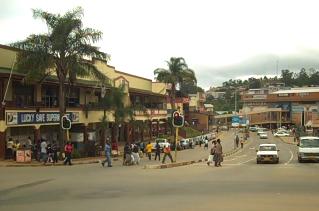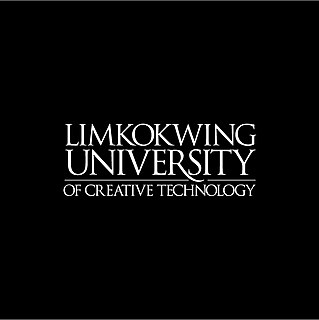
Eswatini, officially the Kingdom of Eswatini and also known as Swaziland, is a landlocked country in Southern Africa. It is bordered by Mozambique to its northeast and South Africa to its north, west and south. At no more than 200 kilometres (120 mi) north to south and 130 kilometres (81 mi) east to west, Eswatini is one of the smallest countries in Africa; despite this, its climate and topography are diverse, ranging from a cool and mountainous highveld to a hot and dry lowveld.
Public transport is the main means of transportation in Eswatini. Car ownership is low, at 32 cars per 1,000 people. The National Road Network has 1500 km of main roads and 2270 km of district roads.

Mbabane is the capital and largest city in Eswatini. With an estimated population of 94,874 (2010), it is located on the Mbabane River and its tributary the Polinjane River in the Mdzimba Mountains. It is located in the Hhohho Region, of which it is also the capital. The average elevation of the city is 1243 meters. It lies on the MR3 road.

Hhohho is a region of Eswatini, located in the north western part of Eswatini from the north and running southwards to the centre, Hhohho was named after the capital of King Mswati II, who expanded the Swazi territory to the north and west, taking in the districts of Barberton, Nelspruit, Carolina and Piet Retief. These areas were later acquired by what was the Province of Transvaal and today they form part of the Mpumalanga Province of South Africa. It has an area of 3,625.17 km², a population of 320,651 (2017), and is divided into 14 tinkhundla. The administrative center is the national capital of Mbabane. It borders Lubombo Region on the southeast and Manzini Region in the southwest.
{Use British English|date=May 2013}}

Manzini is a city in Eswatini, which is also the capital of Eswatini's Manzini Region. The city is the country's second largest urban centre behind Mbabane, with a population of 78,000 (2008). It is known as "The Hub" of Eswatini and lies on the MR3 road. Eswatini's primary industrial site at Matsapha lies near the town's western border.

The University of Eswatini is the national university of Eswatini.

Education in Ghana was mainly informal, and based on apprenticeship before the arrival of European settlers, who introduced a formal education system addressed to the elites. Pre-Independent Ghana was known as the Gold Coast. The economy of Pre-Colonial Gold Coast was mainly dependent on subsistence farming where farm produces were shared within households and members of each household specialized in providing their household with other necessities such as cooking utilities, shelter, home, clothing and furnitures. Trade with other households was therefore practiced in a very small scale. This has made economic activities in pre-colonial Gold Coast a family institution/customs; family owned and family controlled. As such, there was no need for employment outside the household which would have otherwise called for discipline(s), value(s) and skill(s) through a formal education system. Pre-Colonial Gold Cost therefore practiced an informal education(apprenticeship) until it was colonized and its economy became a hybrid of subsistence and formal economy.
Articles related to Eswatini include:

Limkokwing University of Creative Technology is a private international university with a presence across Africa, Europe, and Asia. With its main campus in Malaysia, the university has over 30,000 students from more than 150 countries, studying in campuses in Kuala Lumpur, Melaka, Kuching, Botswana, Cambodia, Cambodia, Lesotho, Sierra Leone, Eswatini, Uganda and the United Kingdom.
Education in Lesotho has undergone reforms in recent years, meaning that primary education is now free, universal, and compulsory.
Matsapha is a town in central Eswatini. The Matsapha urban boundary is defined in the Urban Government Act of 1969, and it was amended in 2012, and it covers an area approximately 2,000 hectares. Matsapha was established as an industrial park in 1965 but was official gazetted as an urban area in 1969. Matsapha is located in the Upper Middleveld of Eswatini. It is located in the Manzini region, which is in the centre of the country. Matsapha is located 11 kilometres (6.8 mi) from Manzini, which is the country's commercial capital and is located 35 kilometres (22 mi) from Mbabane, the administrative capital of the country. It is well located as it lies on Eswatini's main east–west axis between South Africa and Mozambique and 16 kilometres (9.9 mi) from the junction of the Lavumisa road that leads to Durban and KwaZulu Natal. It lies at an altitude of 625 metres (2,051 ft) above sea level.
Prostitution in Eswatini is illegal, the anti-prostitution laws dating back to 1889, when the country Eswatini was a protectorate of South Africa. Law enforcement is inconsistent, particularly near industrial sites and military bases. Police tend to turn a blind eye to prostitution in clubs. There are periodic clamp-downs by the police.
The Swaziland Reformed Church was founded in 1944 and become a congregation of the Dutch Reformed Church in Africa in 1967. Later the Swaziland Missionary Board was formed to coordinate the missionary work of the Reformed Church in Swaziland. In 1989 Swaziland become a Regional Synod of the denomination. In 1991 the Swaziland Reformed Church became independent and has 20 communities within which it is working. The church was a member of the Reformed Ecumenical Council and later became a member of the World Communion of Reformed Churches.
The Mater Dolorosa Church or just Mater Dolorosa Parish, is the name given to a Catholic church located in the city of Mbabane, Eswatini. This just to one side of the same name Secondary and Elementary School..
St Joseph's School is a public co-educational school in rural Eswatini. The school is located on a Catholic mission complex run by the Servite Order. The postal address of the school is Mzimpofu; however Mzimpofu is the simply the name of the post office at the mission and not that of an actual city or village. St Joseph's is well known in Eswatini for integrating the education of students with disabilities with normally-abled students.
Law enforcement in Eswatini is the primarily the responsibility of the Royal Eswatini Police Service, which oversees internal security as well as border and customs control, and His Majesty's Correctional Services (HMCS), which is tasked with maintaining and guarding prisons. It is estimated that about 35% of Government of Eswatini employees work in the security services. The country has been part of INTERPOL since October 1975 and the organization has an office in the capital of Eswatini, Mbabane.






